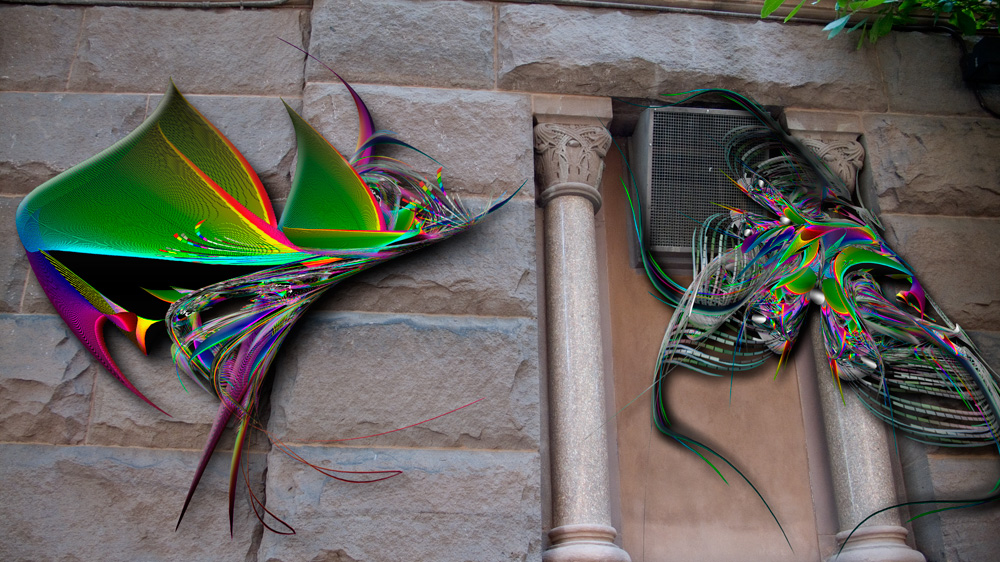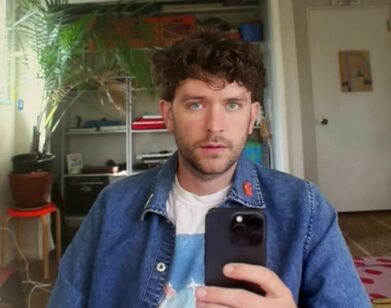Lucas Samaras
Lucas Samaras is not the best-known artist in America, but among the cognoscenti he is considered a wizard, and among artists heâ??s an elusive legend: a loner, eccentric, master of unusual media, and visionary who has avoided classification. Heâ??s a solitary worker who has remained outside of movements, trends, or cliques, making work that is always original, provocative, and surprising. Samaras stands out from the crowd in part because he tends to work with unique subject matterâ??himself. He has interviewed himself, photographed himself, sculpted himself, and decorated himself and, in doing so, he has always seemed to be a work in progress. Samaras is not necessarily a narcissist, even though one of his retrospectives was titled â??Unrepentant Ego.â? He is an intrepid self-investigator and he has made acareer out of mutating his own image and likeness.
Samaras was born in Greece in 1936 and emigrated to the United States with his family when he was 11. He won a scholarship to study art at Rutgers University, enrolling in 1955, at a time when the Rutgers art department was a hotbed of innovation, with a faculty that included Alan Kaprow, who organized the first Happenings, and Geoffrey Hendricks, who, along with Kaprow, George Segal, Roy Lichtenstein, and students like Robert Whitman, was instrumental in the Fluxus movement. Upon graduation, Samaras received a fellowship to attend Columbia Universityâ??s graduate department of art history, which afforded him the chance to get involved with New York Cityâ??s burgeoning Happenings scene, where he met artists such as Claes Oldenburg, Jim Dine, and Red Grooms. His interest in performance also led him to study acting with Stella Adler.
Samarasâ??s first art exhibition, in 1959, earned raves, and, two years later, one of his pieces was acquired by the Museum of Modern Art. He was a significant figure in the New York art world early on, and Andy Warhol once recalled Samaras as being part of a fledgling rock band he tried to join in the â??60s that included Claes and Patti Oldenburg, Jasper Johns, La Monte Young, and Walter De Maria. Over the years, Samaras has made drawings, paintings, sculptures, installations, photographs, furniture, and jewelry. He has been extraordinarily innovative in media, learning to manipulate Polaroids before the dyes set, or employing materials such as razor blades, chicken wire, beads, and gold.
Samaras is known for a series of â??Auto-Interviews,â? in which he interrogates himself, but for Interview this notorious loner spoke to his longtime friend and dealer Arne Glimcher, who may be the person who knows him best. The occasion is yet another remarkable body of workâ??this one composed of computer drawings of chimerical creatures all made on his Mac in the magical aerie where he lives, alone, high above midtown Manhattan, in one of those apartments wherein you might start to think you were an eagle or a god. Since this interview, it has been announced that Samaras will represent Greece in the 2009 Venice Biennale.
ARNE GLIMCHER: Are you famous?
LUCAS SAMARAS: I donâ??t think you could have given me a more insulting question.
AG: Thatâ??s what the whole thing is about.
LS: Oh, is that what it is?
AG: Do you think youâ??re a famous person?
LS: Well, for the year 2050, Iâ??m famous, yes. [laughs]
AG: How important is fame in your life?
LS: I donâ??t want the kind of fame where Iâ??m recognized in the streetâ??except maybe once a year. I couldnâ??t take the constant, â??Are you Mr. so-and-so?â? Now Iâ??m in the shadows, an éminence grise or something. But Iâ??m not sure even Richelieu wanted to remain a sort of hidden presence forever, you know? When he died, he probably said, â??Okay, let the boys know what I did.â?
AG: Well, thereâ??s always that retrospective view of oneâ??s career. But at this point, do you see fame as a recognition of quality, or as . . . Well, you could be an axe murderer and also be famous. What does fame mean right now? I mean, you are famous . . .
LS: Donâ??t pull my extremities, now . . .
AG: Donâ??t pull your what?
LS: My extremities. [both laugh]
AG: If I can, I will.
LS: I think even at a young age I became aware that two kinds of fame were available: One is the kind you get from building this great church; the other is the kind you get from burning it down.
AG: What does that mean?
LS: There is this evil side of fame, where you can destroy something and become famous, like Attila the Hun. Okay, he was a great warrior, but he destroyed God knows how much. So you want the good side of fame. But whether people consider you difficult or snooty or whatever is less important than not having done real damage.
AG: Your work is consistently provocative. Soâ??
LS: Lots of people make provocative work. Whatâ??s the big deal?
AG: No big dealâ??but is the work provocative because youâ??re constantly trying to surprise people?
LS: No.
AG: Or is it that youâ??re constantly trying to surprise yourself?
LS: Itâ??s the mind thatâ??s provocative, itâ??s not the work thatâ??s provocative. Itâ??s like, â??Oh, there he goes doing something strange.â? You donâ??t look at the work and say, â??Oh, thatâ??s provocative!â? Itâ??s the artist creature who does it, right? The creature has that adjective attached to him or her. Then you can also have an aging artist who just goes all over the place and does different stuff . . . But itâ??s all junk, so who cares? Right? We have examples of that. [both laugh]
AG: We do . . .
LS: It has to be well done. Whatever I do has to be well done. And it even has to approach an area of beauty rather than ugliness. It can be rough, but it has to be beautiful.
AG: So, the new photographs that youâ??re making are like incredible gargoyles, dressed in lavish colors, coming out of very nondescript locationsâ??brick walls, courtyards, facades. Are these an extension of the history of architecture with gargoyles? Or are they like supernatural creatures landing from another planet?
LS: The architecture that I use as a background for my performers is just like the set. These backgrounds happen to be shots of New York building fronts. It could be a garage or some fancy building. And what you call gargoyles, that has an ancient history. But as to whether itâ??s a distortion of a gargoyle or a graffiti or a caricature . . . You know, in the past, some of the great ones were done out of really showing something realistically. With [Giuseppe] Arcimboldo, you have a realistically depicted tomato or a cucumber or a flower or some fish, and then the position and the juxtaposition creates a caricature of a face. And then some things come from a distortion, like 20th-century distortions where someone takes a photograph of somebody and then distorts the image. Even if you paint it realistically, you distort itâ??make the nose a little bigger, make the mouth a little wider, the teeth, and so on. But what Iâ??m doing is through computer materials, you know? Nothing originates from a real thing. The intertwining of these materials, these computer materials, are what creates an anthropomorphic sort of image. Itâ??s all made out of computer material. You could say, â??Well, it looks a little bit like your constructions, like fabrics . . .â? Only I donâ??t use fabricsâ??I just use my finger and my cursor and the colors from the computer.
AG: So these things which I referred to as gargoyles . . .
LS: Yeah . . .
AG: Youâ??ve referred to them as performers. Do you see these creations as dancers, as runway models? What do they represent? The opulence and excesses in our society?
LS: It represents everything that happens in front of you, the viewer, or in front of a theater or a stage. It could either be conceived as this performance happening for you, or else something you see when you walk down the street and where you donâ??t know what it is that you saw. I mean, Iâ??m not a historical expert, but itâ??s been suggested that theater was invented when the Greeks put two characters on the stage. With one person, thereâ??s lecturing, but with two characters, thereâ??s a dialogueâ??immediately thereâ??s a confrontation between the two. So in art, thereâ??s one person, the observer, and then thereâ??s the observed, whoâ??s like a different observer.
AG: What about the extravagance of these creatures? I mean, these are incredibly opulent creatures.
LS: When I set out to do a piece and I find Iâ??m doing something different from what Iâ??ve done before, invariably Iâ??ll make two, three, four, whatever, and then Iâ??ll find, all of a suddenâ??itâ??s like a bell ringingâ??that the piece Iâ??ve just made has connections to the past. Iâ??ll remember a mood that was in a painting by so-and-so in the 1400s or the 1780s, you know what I mean? And when I see that, to me, itâ??s an indication of pay dirt. It means Iâ??m connecting to something real, something that happened, something that has automatic substance. And these hints of the past just blow my mind. So when I came upon that point with these figures of caricatures or whatever they are, I thought to myself, â??Gee, thatâ??s like French couture! Those bastards could learn something!â? Itâ??s both making a connection to something that existed and then also saying, â??Gee, I could do it better.â? So thereâ??s that dialogue between me and the outside world.
AG: I find the theatrical connection interesting. You were always involved in theater. It goes back to the Happenings. Do you see a relationship between these pieces and the Happenings or wanting to be an actor?
LS: This series began from a slightly different angle. When my chair show [â??NYC Chairs,â? Februaryâ??March 2008] was on downtown, I began doing a series where I had a background of tiles on the computer, like the kind youâ??d see in a bathroom or in the subway. And then I would computer-paste a photograph on them, like an old photograph of mine, and it would look as if you were walking down the street and saw these advertisements of me from different periods. And that reminded me of the â??60s, when Raymond Saroff filmed some of [Claes] Oldenburgâ??s Happenings. Saroff was not a photographer or a filmmaker, but he was just in love with what was happening, so he took a camera and made a filmâ??which is not perfect in any way. But I did some things for him, and one of the things I did is, we went down in the subway and I took Xeroxes of my face and I taped them up on advertisements as we were passing by. And from there, a couple of months ago, I took out the pictures, and I was left with the backgrounds. They could be tiles, but also it could be a sidewalk where you see two sort of plain sides of a building. And then instead of my photos, I created certain biomorphic shapes, you know? And from the biomorphic shapes I came to a point where something had a vaguely anthropomorphic form, but then some of them looked like a fish or an exotic bird or a couple of animals, and I came click, click, click, into doing a face, or a human body. And then I got to the point where it was sort of actors acting. AG: When you pasted the pictures of yourself on the advertisements in the subway, did you paste your face over the faces of the characters in the ads?
LS: Yeah, it was like a surreptitious thing you did at night, you know? That was before graffiti art came, and graffiti at that time had a different look altogether. It was people making dirty pictures and it was crude and it was very fast. It was wonderful, you know? Because the graffiti artists sort of killed it in a way. They had these spray paint cans and the cans produced a certain kind of line, a thick line. Later on they did some nice graphic stuff, the graffiti artists, but in a way they killed the old graffiti, you know?
AG: The toilet wall graffiti.
LS: Yeah, which was great. But there are still remnants of it in Cy Twomblyâ??s work.
AG: Well, [Jean] Dubuffetâ??s early work is all graffiti.
LS: Yes, exactly. Sure.
AG: Even toilet wall graffiti of Dubuffetâ??s, where the guyâ??s pissing against the wall . . .
LS: Yes. Wonderful stuff. So, in a way Iâ??m doing graffiti, but Iâ??m doing it three-dimensionally. Iâ??m giving it a different form.
AG: The arc of your career is really interesting. You went from being an artist who was very cloistered on 77th Street, in a little tiny room, then to a bigger place, but still cloistered, on the West Side, and your work had nothing to do with what was happening out on the street. It was all to do with the psychology inside your head. Not that the later work doesnâ??t also have to do with that . . .
LS: Did you say pathology?
AG: [laughs] I said psychology. But we could say pathology.
LS: No.
AG: You never used to go out. And suddenly you became this creature of the city, photographing the city. Thatâ??s a huge change.
LS: I had a pseudo-transformative sort of epiphany at a certain point when I decided maybe 20 years ago to remove myself from the presence of friends and relations. It was not an easy thing to do, but nevertheless I wanted to do it. But then what happened was that I would be walking in the park or out shopping or something, and all of a sudden it started to seem as if the park was not this external thing. It was now my park, you know? New York City was my city. I was the owner of everything. So I could walk down a street and there would be tons of people there, walking this way and that way, but they were my people. Itâ??s like they were my animals, my creatures.
AG: That sounds like God.
LS: No, I didnâ??t mean it like God. I just meant that I didnâ??t have to be afraid anymore. And I didnâ??t have to feel guilty that Iâ??d left people or whatever. Itâ??s just that I made . . .
AG: An exchange? A group of personal friends for impersonal friends.
LS: Yeah. So that I could still see them, but there was a slight distanceâ??it was happening out there. But the thing about the park, really, was that every year people would say, â??What are you doing this summer?â? You know? â??Nothing.â? I donâ??t have to go to other places. I have this fantastic park. And I walk down the street . . . wonderful canyons of buildings. And I can also recall what happened years ago in the same streets.
AG: That comes with age, doesnâ??t it?
LS: I think so. I think so.AG: Suddenly you are comfortable in your own skin. And then youâ??re comfortable in the city. I know I feel the same way when I travel to exotic places. When I was younger it would be very scary. Now I just get off the planeâ??itâ??s nothing.
LS: What was scary for you?
AG: What was I going to find? What would I see? Would there be toilet paper? [laughs] Now I just go . . . Citizen of the world. I think it comes with age.
LS: And then thereâ??s probably another help for me, and that is that Iâ??m living very high up. I see the panorama of New York and New Jersey and Staten Island. Thereâ??s quite a difference between that and living on the second floor, like I lived before. That reminds me of something else, of childhood, and how when we were young, 9 or 10 years old or whatever, I was a little different from the other kids because all they were interested in was gossip, who did what and what Iâ??m gonna do and what Iâ??m gonna getâ??none of them had a sense of being enthralled by nature itself and talking about it. And here and there, there were some low hills. When I went up on a hill and looked down, I could really look at nature, you know? But the other kids, I donâ??t think there was any possible conversation available about those things. So whether Iâ??m up on a hill looking down at my lake, or Iâ??m up here and looking down and seeing the Hudson River and so on . . . Well, thereâ??s not much difference, but there is a difference.
AG: There is. You donâ??t have those other kids here.
LS: Well, yes, I do. I have the art world, and they donâ??t understand either.
AG: So what about the art world? Thereâ??s been an incredible transformation in it since our youth.
LS: Yeah, it used to be like two or three cliques. Now, there are like a thousand cliques.
AG: What do you think about the commercialism of the art world? About the artists who are commanding such enormous prices? About the collectors who are speculating on racehorses, really? Do you give it any thought?
LS: Well, the danger is that you begin to reject things that happen outside of you. You donâ??t control that. Whether itâ??s political stuff happening around you, or social stuff, you have no control, unless youâ??re in a position of power to control the aesthetics of the country at some point, or you have the financialâ??
AG: Like Damien Hirst.
LS: Well, itâ??s not only artists. Itâ??s the artists plus the machines behind them.
AG: More and more of these artists are becoming the machines behind themselves.
LS: No, the more they become successful, the more rich that they are, they still need the outside. Like [Louise] Nevelson needed Hilton Kramer and Emily Genauer and the Lipmans, and so on . . .
AG: Yeah.
LS: And you, not to mention . . .
AG: Not to mention.
LS: [laughs] Not to mention you. Without you and all the others, Nevelson couldnâ??t have done anything. She still would have been in Santa Fe or something! No, these individuals are not doing it by themselves.
AG: But because the work is about thatâ??about the distribution of the work, about the fame, the commercialismâ??itâ??s work about what that work is doing!
LS: Oh, you mean now . . .
AG: Yeah, and I think itâ??s work of great cynicism.
LS: Well, [Marcel] Duchamp didnâ??t mean for it to turn out that way. He was the one who did the smart things about production, but everything went the other way.
AG: What was the other way?
LS: The other way is that he became extraordinarily expensive. I donâ??t think he ever wanted any of his pieces going for a $100 million. He, more than anybody else, introduced the idea that you didnâ??t have to make the work. You could just say, â??Itâ??s mine.â?
AG: Right, the selection.
LS: The idea of multiplication was already there. Multiplication and distribution. But Iâ??m not sure that he thought of distribution the way itâ??s happening now. So how do I feel about it? I feel enormously insulted. [pauses] How could I not be insulted?
AG: Okay, how are you insulted?
LS: One is insulted in the way any craftsman is insulted, in the way that anybody who is differentiated from a workman is insulted, right? A craftsman is somebody who spends extra time making something look beautiful, beyond just utilitarian. You might be building a wall, but it has to be a beautiful wall. It could either be a wall or a painting or whatever, right? But if the craftsman is taken for the workman . . . Anyway, with the idea of beauty, although you make allowances for many kinds of beauty, and you put value on it, and you say, â??Gee, this is better than that . . .â? But the value thatâ??s placed on certain objects now is so grotesque that it loses the meaning of putting a value on anything.
AG: Because the work is suddenly only about the value. And the work is judged by its value.
LS: Yeah. So itâ??s outside of aesthetics, unless valuation becomes the aesthetics.
AG: Well, I think that has become the aesthetic. I think that is the aesthetic of the now. LS: All I wish to say is that art is important, maybe for about 10 or 20 years, and then you forget about it and go on to something else. Maybe 10 years from now all that kind of stuff is going to disappear anyway . . .
AG: Well, I once said to Dubuffet, when his works were already bringing in a great deal of money, â??When the early work was made, it was so provocative that people thought it was the art of a madman. When you showed it in â??44 in Paris at René Drouin, it was shocking. Now the work is bringing in millions of dollars and hanging in the great museums of the world. Do you still think that the work is valid and effective?â? And he said no. He said it was only effective for the period of time that it was challenging. He said, â??Now itâ??s just an artifact.â?
LS: I think heâ??s wrong in not taking into consideration new people who come upon the work, who donâ??t come with a million bucks or a billion bucks behind them. It can certainly be effective for them, so we can disregard Dubuffetâ??s modesty.
AG: I donâ??t think it was modesty. I thinkâ??
LS: Or it was sadness.
AG: Or sadness. Probably sadness. But we went from a period where art was very shocking to a period now where art is incredibly respectable. Isnâ??t that a fantastic thing to see in our lifetimes?
LS: No, art is not respectable.
AG: You donâ??t think the [Jeff] Koons rabbit . . .
LS: Well, five people plunking down $100 million doesnâ??t make it respectable.
AG: It does garner respect, that amount of money.
LS: From those individuals plus the media. Then itâ??s gossip. Anything about money is gossip for them.
AG: So do you feel threatened by the new artists
LS: I always wasâ??well, not threatened, but saddened. Even 30, 40 years ago when I did my first mature work, my first adult work, and it didnâ??t get attention from intelligent people, I was so insulted. Other people were doing really much worse stuff. [laughs] So I said, â??Oh, so thatâ??s how itâ??s gonna be?â?
AG: Your work continues to be outside the contemporary current.
LS: No matter what Iâ??m gonna do, itâ??s not gonna be easy. And thereâ??s always somebody else to take it down. Thereâ??s always somebody else or some group who is waiting to gun it down.
AG: Once you put it out.
LS: Especially now with the Web. Itâ??s like when [John] McCain and [Sarah] Palin went out speaking, and she said â??Barack Obama,â? and someone said, â??Kill him! Kill him!â? Some idiot. Out of 5,000 people, this idiot yells, â??Kill him!â? The Web is like that. No matter what you do, the most gorgeous thing youâ??ve ever seen, somebody writes, â??Oh, what a piece of shit. I couldâ??ve done something like that overnight.â?
AG: So theyâ??re saying, â??Kill himâ??
LS: In other words . . .
AG: Have you had reviews like that on the Web, from your shows and things like that?
LS: Yes.
AG: Really?
LS: I used to get stuff like that from intelligent people. And now you get it even from jerks.
AG: So what do you look at it for?
LS: Well, to see maybe if Iâ??ve skipped by something that was terrific, you know? [laughs]
AG: Certainly a major aspect of your work is always its sensuality, or eroticism, as in your self-portraiture. Are these new characters self-portraits?
LS: You know, I just had this little insight a couple of hours ago about my work. Some of the great brains of the time always mention the word narcissism, you know?
AG: Mm-hmm.
LS: And I was thinking, with narcissism, or with its more pure form, masturbationâ??you masturbate, masturbate, masturbate, and then you have an
ejaculation, and thatâ??s it. Whereas the way Iâ??m making work, I use my fingers, just as in masturbation, you know. I move this way, that way, this way, that way, and Iâ??m going, â??Okay, looks good . . . looks good . . . very good . . . not bad . . . and then, Oh!â? The ejaculation is you finish the piece and it looks terrific. And then tomorrow you look at it and you get the same effect that you had when you were making it. So once I make it, itâ??s continuous. I donâ??t have to masturbate, you know? Itâ??s not the work that Iâ??m making. Once it achieves fruition, itâ??s just there to make my life wonderful day after day without my doing that thing anymore. I do something else.
AG: Right.
LS: So the work canâ??t be masturbation. Masturbation is a cheap way of describing what Iâ??m doing. Itâ??s such a thrilling, thrilling process that continues giving, making children.
AG: But this is kind of spiritual.
LS: Well, I donâ??t know what it is, but it has something that keeps me alive.
AG: So where do you see the future going from these works?
LS: For me, itâ??s always the same routine. I do something and if itâ??s no good, itâ??s no good, and I go on to something else. I achieve something that I think is fantastic and then I wait for the gallery to make their visit and say, â??Ooh, thatâ??s fantastic. Letâ??s show it.â? And then they show it, and they have the catalog, and people come to see it, and itâ??s either lauded or not lauded. And then I go on to something else.
ARNE GLIMCHER IS CHAIRMAN OF PACEWILDENSTEIN, THE ART GALLERY WITH VENUES IN NEW YORK AND BEIJING. HE IS ALSO AN AUTHOR AND A DIRECTOR AND PRODUCER OF FEATURE FILMS.Â







